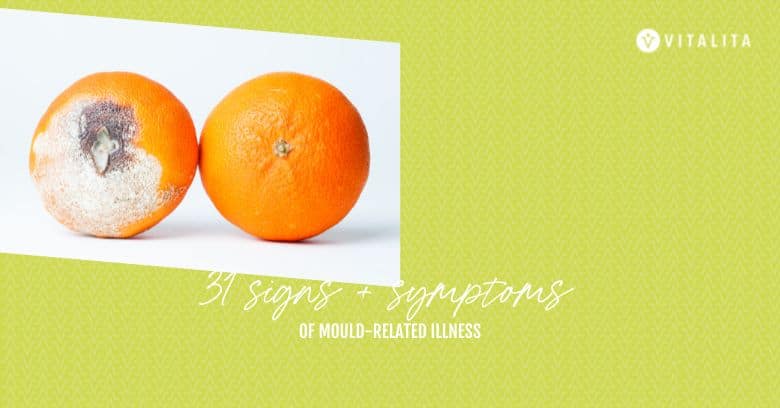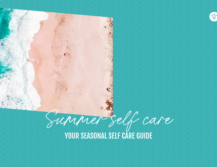
In holistic health circles, mould is known as ‘the great imitator’.
In fact, before I discovered I had a biotoxin illness caused by mould, a number of alternative diagnoses were thrown around.
Premature menopause, hypothyroidism, insulin-resistance, Binge Eating Disorder, iron deficiency anemia, uterine fibroids, endometrial polyps, Gastroesophageal Reflux Disease, H Pylori, coeliac disease, and Pyroluria.
You name it, we went there!
It’s been a looooooong journey and you can read more about it here.
Signs and symptoms of mould-related illness
I never thought twice about the buckets catching water from poorly-sealed windows and leaking ceilings, in countless Pilates studios and gyms where I worked and trained. Nor did I bat an eye at the rising damp and mould blossoming across walls and ceilings in London flat shares.
My experience of mould-related illness opened my eyes to the way we have normalised the presence of mould in our homes and workplaces. Just because mould is common, doesn’t mean it is normal or healthy.
It is thought that roughly 25% of people are genetically predisposed to the effects of mould exposure. Research suggests that those with the HLA-DR gene are unable to bind and eliminate biotoxins, including the mycotoxins produced by mould. These toxins accumulate and recirculate in the body, resulting in a bevy of symptoms.
Mould toxicity or Chronic Inflammatory Response Syndrome (CIRS) is not just allergies. It’s a multi-system, multi-symptom illness that is gaining credence in the medical community.
Symptoms associated with mould toxicity include*:
- Fatigue
- Muscle weakness
- Unexplained muscle or joint pain
- Ice pick pain
- Headaches
- Light sensitivity
- Red eyes, blurry vision or dry eyes
- Sinus congestion, pain and infection
- Nosebleeds
- Cough
- Shortness of breath
- Abdominal pain
- Digestive issues including food sensitivities, IBS, bloating, gas, diarrhea, constipation,
- Morning stiffness
- Memory issues including brain fog, lack of focus, difficulty recalling words, decreased learning of new knowledge, confusion and disorientation
- Lack of motivation
- Psychiatric symptoms including mood changes, anxiety and depression
- Skin sensitivity and skin conditions such as eczema
- Rapid or significant change in weight (increase or decrease)
- Appetite changes, including increased cravings
- Sweating, especially night sweats
- Inability to sweat
- Temperature Regulation or disregulation problems
- Excessive thirst despite frequent water intake
- Increased urination
- Static shocks
- Numbness
- Tingling
- Vertigo
- Metallic taste
- Tremors
In addition, some people experience co-infections, such as Lyme disease, Epstein-Barr virus or parasites.
Mold symptoms don’t fit into a tidy checklist that applies to all people. It’s better to look at a summation of symptoms. The more symptoms we check off, the more confidence we have in the diagnosis of mold sickness – Dr Jill Crista
Dr Jill Crista is a pioneer in the field of mould-related illness. If you want to learn more, her website and book, Break the Mold, are a great starting place to learn about species of mould, symptoms, the diagnostic process and options for treatment.
What to do if you think you may be suffering from mould-related illness
First of all, take a deep breath then keep reading.
Here are the 3 steps I took when I suspected mould-related illness.
Step 1. Make a list of your symptoms
There is no single symptom that confirms or defines mould sickness.
By the time I was diagnosed, I’d compiled a 15-page chronology . To help jog my memory I used calendar appointments, pathology reports and emails sent to health professionals over the years. Don’t forget to include significant events, such as flooding or time spent in water-damaged buildings (even if it was a long time ago!).
Step 2. Find a mould-literate health practitioner
Whether this is a functional medicine practitioner, naturopath or nutritionist, find someone who understands the effects of mould on the human body, and has experience testing and treating. Do not take no for an answer! Trust your gut and advocate for what you need.
I am personally working with Dr Laurence Rossato-Pudmenzky, a compassionate and collaborative health practitioner based in Brisbane, Australia.
Step 3. Be patient
When you look at the extensive list of symptoms, it’s no wonder it takes time to diagnose mould-related illness. But please don’t give up. You are stronger than you think and you can conquer mould to reclaim your vitality!
– Georgina –
 Georgina Siddall is a joyful and creative woman with a penchant for leopard print, spreadsheets and early mornings.
Georgina Siddall is a joyful and creative woman with a penchant for leopard print, spreadsheets and early mornings.
She is the co-founder of Vitalita – a health and wellness business dedicated to empowering busy women. As a Women’s Life and Wellness Coach, and teacher of mindful movement and meditation, she helps busy women conquer stress, exhaustion and overwhelm, so they can excel in mid-life and beyond.
* I am not a medical or health professional and the content provided in this blog is for informational and educational purposes only. It is not intended to diagnose, treat, prevent or cure any medical condition, and is not a substitute for professional medical advice. If you think you may be suffering from mould-related illness, please consult a medical professional or healthcare provider.










